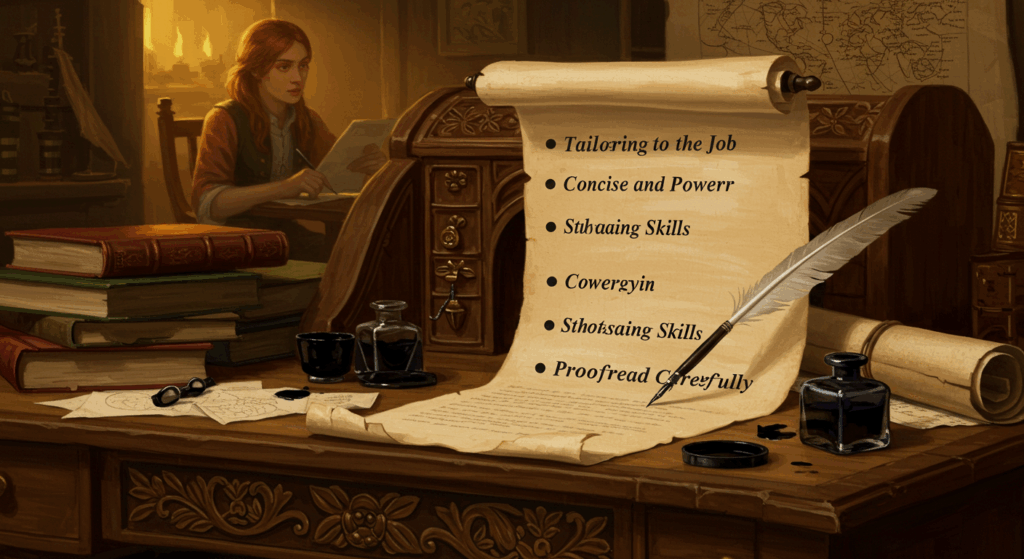Okay, You’ve got a resume that slaps, a LinkedIn that’s at least 73% less cringey than it was last year, and a handful of job tabs open like it’s a Netflix watchlist. And then the application hits you with the “Upload Cover Letter” field. Ugh. Do you really need one? Or is this like adding parsley to pasta—technically optional, might look nice, but won’t change your life?
I’ve been on both sides: applying, helping friends apply, and talking to hiring folks who have Opinions™. So here’s the vibe: a cover letter is not a magic spell. It won’t turn a wildly underqualified résumé into a Cinderella story. But—ngl—it can be the difference between “meh” and “ok wow” in a bunch of very normal hiring situations. The importance of a cover letter depends on context: the company, the role, the app portal, and the story you need to tell. And there’s smart advice (we’ll get there) to keep it short, useful, and not cringe.
Let’s break this down like a friend who’ll actually give you the screenshot-worthy notes (and probably send you a meme afterward).
What a Cover Letter Actually Does (in plain English)
Think of your resume as your Spotify library: facts, tracks, playlists, and nothing else. A cover letter is you explaining why you hit repeat on certain songs and what kind of vibe you’re bringing to the party. The best ones do three things:
- Context: It connects your dots. Why this role, this company, right now?
- Translation: It turns your experience into the employer’s language. You did X → they care about Y → here’s the bridge.
- Signal: It shows effort and tone—your professional “voice.” Not corporate-robot, not essay mode; just clear, confident, and relevant.
If your resume says “I did stuff,” your cover letter says “here’s why that stuff actually matters to you, dear hiring manager.”
The Importance of a Cover Letter in Today’s Hiring
Some apps go through an ATS first (Applicant Tracking System), and yes, sometimes nobody reads the letter. But when humans do see it—recruiters, hiring managers, team leads—that’s where the importance kicks in:
- Tie-breaker power: If two candidates look equal on paper, the one who explains their fit wins.
- Narrative control: Career change? Employment gap? Unconventional path? The leter is your TikTok voice-over that clarifies the plot.
- Company-specific love: Naming what you like about their product, team, or mission shows you did your homework. People can tell.
- Tone check: You can be competent and kind, ambitious and collaborative—your letter hints at what it’ll feel like to work with you.
Basically, it’s small but mighty. Think hot sauce, not entrée.
Situations When a Cover Letter Helps a Lot
This is where a cover letter’s importance really jumps. If any of these situations fit, your “Do I need a cover letter?” becomes “Yes, please—make it count.”
You’re Switching Careers or Functions
Your resume bullets might scream “marketing,” but you’re applying to product. The letter is where you map transferable skills (research, user empathy, experiments, data storytelling) to product outcomes. It’s also where you explain your why without sounding like, “I’m bored.”
You’re Early Career (Internship, New Grad, First Role)
No 10-year work history? Cool. Use your letter to connect class projects, clubs, part-time work, and side quests to real business value: deadlines, teamwork, customer service, outcomes. Show you get how business works, even if your experience is scrappy. Hiring managers respect scrappy.
You’re Applying to Mission-Driven, Nonprofit, or Public Roles
These teams care about alignment. A short paragraph on why the mission matters to you (with specifics, not generic “I’m passionate” lines) can carry legit weight.
The Role Demands Communication or Stakeholder Skills
Sales, partnerships, customer success, project management, community, comms, HR, operations—basically anything human-heavy. Your letter doubles as a writing sample. If you can’t convince in 250–400 words, that’s a flag.
The Job Post Explicitly Asks for It
Low-key obvious, but let’s say it: if they ask, do it. Some teams use the letter as a signal for attention to detail.
You’re Referred or You Met Someone on the Team
A quick “I spoke with Maya (Growth PM) about your product roadmap…” is such a strong opening. It grounds your interest and signals network fit.
You’re Remote-First or Global
Explain how you operate async, manage time zones, and collaborate without 12 meetings. That’s way more convincing than a generic “I’m a team player.”
You Need to Explain a Gap, Move, or Nonlinear Path
Hiring managers aren’t allergic to gaps; they’re allergic to mystery. A short, direct sentence is plenty: “I took six months to care for family and I’m excited to return to a growth-focused role.” Done.
Situations When You Can Skip It (and Not Self-Sabotage)
Not every app deserves your Sunday afternoon. These situations are where skipping is defensible:
- Walk-in or high-volume hourly roles (retail, warehouse, service) where the process is built for speed.
- Super-short portals that don’t allow attachments and only want your resume + a few questions.
- Recruiter says “send the resume only”—follow the instructions (though you can paste a mini-note in the email body).
- Internal transfers using a form with application questions that already capture motivation and fit.
- Rapid-apply rounds (think 20+ roles in a sprint). Prioritize: write tailored letters for top-tier roles and skip lower-priority ones.
If you skip, try to leave something thoughtful in the optional text box or email body—a tight 3–4 sentences with your key value prop.
Advice: How to Write a Cover Letter That Doesn’t Feel Cheesy
You don’t need a Victorian novel. You need ~250–400 words of focused, human, relevant writing. Here’s the advice I give friends (and use myself):
Keep It to Five Micro-Sections
- Hook (1–2 sentences)
One specific thing you admire about their product, customers, or strategy. “I’ve shipped onboarding flows at fintech startups and I love how your app demystifies credit building for Gen Z—especially the budgeting nudges.” - Fit Summary (2–3 sentences)
One clear through-line from your background to their goals. “Across 3 roles, I’ve increased activation by combining user research with rapid experiments. I’d bring that same bias to your growth squad.” - Proof (2–4 bullets)
Short bullets with metrics/outcomes.- Cut churn 14% QoQ by rebuilding cancellation UX and adding ‘save’ offers.
- Launched referral loop that drove 28% of new sign-ups in 90 days.
- Reduced time-to-value from 3 days to 18 hours via guided setup.
- Bridge to Role (1–2 sentences)
Name the team/tool/metric you want to impact. “I’m excited to partner with data and lifecycle to grow activation from 42% to 55%.” - Close (1 sentence)
Confident, warm, not desperate. “Thanks for considering—happy to share a quick Loom or chat about experiments I’d run in month one.”
Tone Tips (So It Sounds Like a Person Wrote It)
- Write like you talk—tight, positive, and specific.
- Avoid fluff: “I’m passionate,” “fast learner,” “hard worker.” Show it instead.
- Use one brand-specific compliment you can’t copy-paste to other companies.
- Keep the vibe humble-but-competent. Confident, not cocky.
- Tiny imperfection is fine (you know, a casual aside or “ngl”), but proofread.
Formatting & Logistics (Because Details Matter)
- Length: Aim for 250–400 words. If your resume is chef’s kiss targeted, 200 words can work.
- File: PDF with a clean filename:
First-Last-Role-Cover-Letter.pdf. - Header: Include your contact info + date + role title + company.
- Addressing: “Hi [Team/Name],” > “To Whom It May Concern.” If unknown: “Hi Hiring Team,” is fine.
- Email vs Attachment: If you’re emailing a recruiter directly, paste it into the email body (shorter) and attach the PDF too.
- ATS Keywords: Sprinkle 3–6 exact phrases from the job post that you actually have. Don’t stuff, don’t lie.
- Accessibility: Use plain text (no images), readable font if you’re sending as doc, and simple structure.
A Tiny Template You Can Personalize in 10 Minutes
(Steal this and tweak it. Promise I won’t snitch.)
Hi [Name / Hiring Team],
I’m excited to apply for the [Role] at [Company]. I’ve followed [product/mission] and especially love [one specific feature, campaign, result, or customer impact]. It speaks to how you [do X] for [audience].
In my last [role/company], I focused on [core responsibility], which maps to your need for [requirement from job post]. Across [timeframe], I [what you did] and learned [relevant lesson about users, systems, or outcomes].
Highlights:
- [Metric/result #1 tied to this role]
- [Metric/result #2]
- [Metric/result #3]
I’m excited to bring this to [Company], especially around [team/metric/tool mentioned in the posting]. Thanks for your time—happy to share more examples or ideas for the first 30–60 days.
Best,
[Your Name]
[Link to LinkedIn/Portfolio]
Plug-and-Play Lines for Common Situations
Sometimes you just need the sentence. Copy, remix, make it yours:
- Career Switch to Product: “I’ve run 30+ customer interviews as a marketer, and I’m excited to apply that research brain to roadmap decisions and experiment design.”
- Customer Success → Account Manager: “I’ve retained 94% of my book by pairing proactive QBRs with expansion plays; I’m ready to own a quota with the same consultative approach.”
- Recent Grad: “The capstone was cool, but the real teaching moment was shipping three messy prototypes and watching users ignore my favorite one—humbling, useful, and addictive.”
- Design: “I measure success by task completion and sentiment, not dribbble likes; my last redesign cut time-on-task by 32% while keeping CSAT at 4.7/5.”
- Engineering: “I care about boring reliability—fewer incidents, faster rollbacks, happier devs; my last IaC overhaul dropped deploy time from 20m to 6m.”
- Ops: “I love shaving minutes and clicks; my SOP refresh removed 7 steps from onboarding and got new hires productive by day two.”
- Gap Year: “I paused to care for family; I’m now fully available and energized to dive into [role], bringing sharp focus and real-world calm.”
- Remote: “I work async by default—clear PRDs, crisp Looms, and reliable documentation so we aren’t blocked by time zones.”
15-Minute Cover Letter Sprint (When You’re Tired but Still Want to Win)
Minute 0–3: Screenshot the job post.
Highlight the 3–5 phrases that keep repeating (e.g., “activation,” “SQL,” “stakeholder communication,” “lifecycle email”). Those are your anchors.
Minute 3–6: Pick three receipts.
What have you done that matches those phrases? Jot 3 bullets with numbers or clear outcomes.
Minute 6–9: Draft the hook and fit line.
One swntence about their product/team, one about how your experience maps.
Minute 9–12: Paste your bullets and add a bridge.
Add 2–3 bullets. Write one sentence linking your proof to their goals.
Minute 12–15: Clean up.
Cut fluff words, check tone, add filename. Deep breath. Send.
Done. Not perfect, but honestly, the bar for cover letters is lower than you think—most people don’t write them at all, or they write a wall of clichés. You’re already ahead.
FAQ: Answers to Stuff Everyone Overthinks
Do hiring managers even read them?
Sometimes yes, sometimes no. But when they do, it can absolutely be the nudge that gets you an interview—especially in close calls or nuanced situations.
How long should it be?
Aim for 250–400 words. If you can make a compelling case in 200, do that. Dense and useful > long and fluffy.
PDF or Google Doc?
PDF. Clean, stable, less formatting chaos. Keep the filename human: Ari-Putri-Product-Manager-Cover-Letter.pdf.
Generic vs tailored?
Tailored. I know. But even one paragraph customized to their product/mission moves the needle. Think 70% reusable, 30% bespoke.
What if I’m cold-emailing?
Make it the email body. Shorter. Clear subject line: Application: Lifecycle Marketer — [Your Name].
What if I have a portfolio?
Link it once, and mention one project that’s most relevant to the role. Don’t list ten links; pick the best hit.
Can I use AI to help?
Yep—for brainstorming, structure, or polishing. Just make sure the final story is yours and matches your resume receipts. If you wouldn’t say it out loud in an interview, don’t put it in the letter.
Can I skip a cover letter if the app doesn’t ask?
If it’s a top-choice role or you’re in any of the “letter helps a lot” situations above, attach one. If it’s a numbers game spree, save your energy and at least drop a strong note in an optional field.
Importance, Situations, Advice: A Quick Recap You Can Screenshot
Importance: It’s small but mighty. A cover letter won’t rescue a totally off-target resume, but it will seal deals in tie-breaker moments, explain context, and show you care.
- Situations: Write one if you’re switching careers, early-career, mission-driven, remote-first, communication-heavy, referred, or need to explain something. Skip (or keep it super minimal) in high-volume or short-form processes.
- Advice: Keep it 250–400 words. Five-piece structure (hook, fit, proof, bridge, close). Concrete metrics. Brand-specific compliment. PDF. Confident, warm tone.
A Few Micro-Examples (Because seeing it helps)
Example 1 — Growth Marketer → Lifecycle Role
“Hi Team—your nudge-based budgeting feature is genius; I worked on a similar ‘micro-commitment’ loop that drove a 28% lift in weekly actives. Across two roles, I’ve planned lifecycle programs from CSV to tooling, and I’d love to partner with data to push activation above 50% in Q4. Recent wins: cut unsubscribes 18% by improving preference center, launched a referral winback that added 1.1k retained users. Happy to share a quick 30–60–90 for experiments.”
Example 2 — Customer Support → Customer Success
“Hi Hiring Team—your 4.8 app rating shows a real culture of care. I’ve spent three years in support resolving 2.5k+ tickets with 95% CSAT, and I’m excited to move upstream into proactive success. I built a self-serve library that cut repetitive tickets 22% and a renewal reminder flow that saved 14 accounts last quarter. I’d bring the same playbook to reduce churn and expand accounts in your SMB segment.”
Example 3 — Career Change to Product
“Hi [Name], I’m moving from UX research to associate PM after leading 40+ interviews that informed two roadmap bets. I love that your team ships small, testable changes; my last project turned a ‘skip onboarding’ into a guided nudge that doubled task completion. I’d be excited to partner with engineering on a two-week AB cadence around your activation milestones.”
None of these are perfect. But they’re concrete. They feel like a person. They connect your work to what they care about. That’s literally the job.
When You Don’t Have Time (But Really Want the Interview)
Here’s your minimum viable move if the portal doesn’t ask for a letter but there’s a text box:
“Hi team—applying for [Role]. I’m excited about [1 specific product/mission detail]. In the past year I [2 short metrics aligned to the job]. I’d love to help [Company] move [metric] from [X] to [Y] by [high-level approach]. Resume attached; portfolio linked. Thanks!”
That’s like 45 seconds. Add seasoning (your specifics), hit submit.
Final Thoughts: Your Time Is Precious, Use It Where It Counts
The internet loves absolutes—“Cover letters are dead!” “Cover letters are essential!” Reality is messy. The importance of a cover letter changes with the situations you’re in. Sometimes skipping is totally fine; sometimes a short, sharp note is the easiest win of your whole app. If the role is top-tier for you, write it. If it’s a numbers game day, prioritize and move.
Or else, If you remember nothing else, remember this advice: be specific, be short, be you.
You’ve got this. Seriously. Pick one role you actually want, write the 250–400 words that only you can write, and send it today. Then reward yourself with something cozy (tea, Netflix, a walk, whatever). Future you will be like, “Dang, thanks.”









